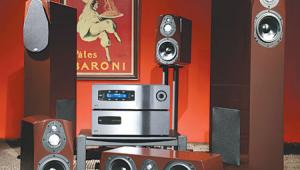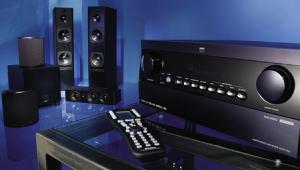Polk Audio RM40T Speaker System, Hitachi 42HDT52 Plasma HDTV, Yamaha RX-4600 A/V Receiver, and Yamaha DVD-S2500 DVD Player Page 2
 Sorting through the HD Radio function was trickier. Good for Yamaha for being a trailblazer with this nascent technology, but setup required a four-page addendum to the original owner's manual. You can only access some of the functions from the front panel, others only from the remote. It should have been a lot easier to program and no doubt will be in the next generation.
Sorting through the HD Radio function was trickier. Good for Yamaha for being a trailblazer with this nascent technology, but setup required a four-page addendum to the original owner's manual. You can only access some of the functions from the front panel, others only from the remote. It should have been a lot easier to program and no doubt will be in the next generation.
In the end, I could receive five New York–area HD Radio stations on FM (indicated by a small illuminated HD on the front of the display). One of the stations, 101.1, used to play oldies, the comfort music I often turned to when I wanted to belt out an old favorite. I don't know if it was changing demographics or the fact that a monaural recording of Dion and the Belmonts won't translate well to HD Radio, but, in the HD Radio age, I discovered that the oldies format is now gone. It had been replaced by an odd shuffle-type format described as "we play what we want" punctuated by fits of incessant chatter. Sound quality of the broadcasts is better, but I can't say the content is.
HD Radio is still new technology on the broadcaster side, too. The only text info available on the stations I received seemed to be self-serving: radio station call letters, FM frequency, and Yamaha's preset numbers. Apparently, artist and track info isn't being sent out from the head end. That was a big disappointment, since I'm completely spoiled by satellite radio's artist and track info.
Sound quality, though, was terrific across the board. The difference between changing from an HD channel to a non-HD one is comparable to going from HD to analog TV. I didn't realize before how annoying the hiss on FM can be. I look forward to the day when all stations deliver this kind of stereo separation and rich, full-range sound.
The DVD Side
From radio, I moved on to DVDs. I had assigned an HDMI input to the DVD player on the receiver and couldn't figure out why I wasn't getting sound. I finally realized that I had to select HDMI from the DVD player's audio setup menu. That's also where I would have selected SACD as a playback option, but that would have required using six analog cables from the DVD player to the receiver (at least in the current generation of HDMI). If I'm going to have this way-cool-looking setup, I'm not going to junk it up with a rat's nest of wires. Such is the dilemma of the flat-panel age. Fortunately, DVD-Audio will pass through HDMI unscathed.
 As a player, the DVD-S2500 was well up to the task. The demo disc du jour—House of Flying Daggers—looked very good. The plasma TV and the DVD player combined to display many nuances of blues, reds, and countless other hues that pepper this trophy disc.
As a player, the DVD-S2500 was well up to the task. The demo disc du jour—House of Flying Daggers—looked very good. The plasma TV and the DVD player combined to display many nuances of blues, reds, and countless other hues that pepper this trophy disc.
The DVD-S2500 served as my CD player, too, and I fiddled around with Yamaha's various DSP modes. That never lasts long, though. Once I amused myself by placing Santana, Herbie Hancock, and Angelique Kidjo within the appropriate Roxy Theater and then with extreme reverb in a cathedral in Freiburg, I was pretty much over the DSP thing. I think Yamaha does the surround modes better than almost anybody, but the concept has lost its appeal to me now that there's Dolby Pro Logic II and DTS Neo: Music. The Neo: 6 setting just may stick. I was blown away by John Mayer and Herbie Hancock's "Stitched Up" from the Possibilities CD spread out in its 5.1-channel mode.
A major part of the credit has to go to the Polk speakers, of course. The RM Series, led by the RM40T floorstanding speaker, works perfectly in this basement arrangement because the speakers are attractive and slim next to the gorgeous plasma, and they still deliver excellent punch and detail. The jangling glass beads of Flying Daggers can sound grating if not handled well, and the sound of steel on steel can be like nails on a chalkboard with inferior speakers. The Polks sounded effortlessly natural with soundtracks and music. The sword detail was astonishing. The surround effects in Flying Daggers was better than I've heard on other systems—not only the popular stone-and-drum sequence but the subtle background sounds that give ambience to the quiet scenes.
 The RM201 surround speaker requires mounting to a base; it can't stand on its own. The good news is that the base hides the speaker wire and connections; the bad news is that you can't see if a wire comes unplugged. When it does, you'll need to find a screwdriver to remove the stand and rethread the wires. That's a very minor issue, though, and credit to Polk for providing both the base and wall-mounting options.
The RM201 surround speaker requires mounting to a base; it can't stand on its own. The good news is that the base hides the speaker wire and connections; the bad news is that you can't see if a wire comes unplugged. When it does, you'll need to find a screwdriver to remove the stand and rethread the wires. That's a very minor issue, though, and credit to Polk for providing both the base and wall-mounting options.
The RM302 center channel is the one piece of gear in this setup that just misses aesthetically. It's a tough issue to produce enough sound and clear dialogue from an enclosure that has to be smaller than the other two front speakers. In my setup. the top of the nearly 6-inch-high RM302 overlaps the bottom of the plasma display. Although I can still easily see the entire screen, sometimes the remote commands don't take because the speaker blocks the TV's IR sensor. Sound-wise, though, the RM302 is as smooth and natural as the other members of its family, and it's a functional family.
The first subwoofer I ever had was about four times the size of the Polk PSW404, and it had nothing on the PSW404 output-wise. The 200-watt-rated sub filled my large room adequately in the 11 o'clock position, so I pushed it to 1 o'clock to let it flex. I couldn't ask more from a box so compact. At 14.3 by 13.6 by 16 inches, this sub does what I need it to do without being an eyesore in a multipurpose room.
My basement gets cold in the winter, so I don't usually think about watching a movie there—until now. It's going to be tough to move the old gear back into place. How can I go back to a tube TV and boxy speakers? Maybe I won't.
Highlights
Polk RM40T Speaker System:
• Tall, slim design matches flat-panel TV
• Wire management designed in
- Log in or register to post comments





















































